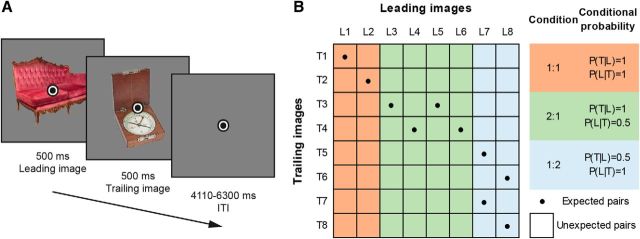Figure 1.
Paradigm overview. A, A single trial, with two example images and superimposed fixation bull's-eye. Leading images and trailing images were presented for 500 ms each, without interstimulus interval, followed by an intertrial interval of 4110–6300 ms (fMRI session; 1500–2500 ms during behavioral training). Participants responded to upside-down images by button press; the image at either position (leading or trailing) could be upside-down. B, Image transition matrix determining image pairs. Eight leading images (L1–L8) and eight trailing images (T1–T8) were used for each participant. Conditional probability conditions are highlighted, and their respective conditional probabilities during training are listed on the right: orange represents the 1:1 condition; green represents the 2:1 condition; blue represents the 1:2 condition. Cells with dots represent expected image pairs. Empty cells represent unexpected pairs.

